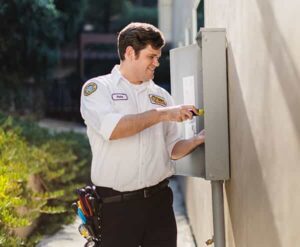Do You Need Home Surge Protection Against Lightning Strikes?
Hey there, fellow homeowners! Let’s talk about something that might not be on your radar but probably should be: home surge protection against lightning strikes. I know I know – it sounds like one of those things you’ll get around to… eventually. But trust me, it’s worth giving some thought to right now.
Picture this: You’re chilling at home, maybe binge-watching your favorite show, when suddenly – BOOM! – a massive lightning strike lights up the sky. Your lights flicker, and for a split second, you’re thinking, “Uh-oh, what about all my gadgets?” Been there, done that, right?
The Threat of Lightning
Here’s the deal: Lightning is Mother Nature’s way of flexing her muscles, and she doesn’t care about your fancy TV or that computer with all your family photos. When lightning strikes, it can send a massive surge of electricity through your home’s wiring. Think of it like trying to force a tidal wave through a garden hose – it’s not going to end well for your poor electronics!
Why Home Surge Protection Matters
Now, you might be wondering, “Do I need surge protection?” Well, let me put it this way: Do you like your expensive gadgets? Because lightning isn’t the only bad guy here.
Even everyday stuff like turning on your AC can create little surges. But yeah, lightning is the big, dramatic villain in this story.
How Surge Protectors Work
So, how do these surge protectors work? Imagine your home’s wiring is a busy highway and electricity is the traffic. A surge protector is like a super-smart traffic cop, directing any crazy, out-of-control electricity away from your valuable devices. Pretty neat, huh?
Types of Surge Protection
There are a few different types of surge protection you can go for. You’ve got your whole-house protectors, which are like bouncers at the door of your home’s electrical system. Then there are point-of-use protectors – you know, those power strips with extra superpowers. And if you’re feeling fancy, there are even power conditioners that smooth out the electricity flow
Real-Life Scenarios
Let me tell you a quick story. My friend Jane thought she’d be fine without surge protection. One stormy night, lightning struck nearby, and ZAP! – her TV, computer, and even her fridge bit the dust.
All that could’ve been avoided with some simple protection. Also, my neighbor Susan thought surge protectors were overkill until one saved her entire home office setup during a nasty storm. Now she swears by them!
The Costs Involved
Surge protection doesn’t need to break the bank. Whole-house protectors typically range from $200 to $500, including installation. Point-of-use protectors are even cheaper, usually between $20 and $100. Compare this to the cost of replacing your gadgets and appliances, and it’s a no-brainer.
Common Myths Debunked
Let’s bust some myths while we’re at it. First off, it’s not just computers that need protection – anything plugged in is fair game. And no, your circuit breaker isn’t going to save you from surges. Oh, and don’t think your insurance will make everything okay – it might help with costs, but it can’t bring back lost data or save you from the headache of replacing everything.
Simple Steps to Get Started
So, ready to get started? Here’s what you do:
- Figure out which of your gadgets you absolutely can’t live without.
- Chat with an electrician about getting a whole-house protector.
- Grab some point-of-use protectors for your most precious electronics.
- Don’t forget to replace them now and then – they don’t last forever!
The Importance of Regular Maintenance
While home surge protectors offer a great defense against power surges, they can’t last forever. It’s important to regularly maintain and replace your surge protectors according to the manufacturer’s recommendations. This ensures that they are functioning properly and providing optimum protection for your devices.
Regular maintenance also allows you to identify any potential issues with your home’s electrical system that could be causing frequent surges. By addressing these problems, you can prevent further damage to your electronics and potentially save on expensive repairs down the line.
In addition, some home surge protectors come with indicator lights that signal when they need to be replaced. Be sure to pay attention to these indicators and replace your surge protector as needed.
Look, I get it. Home surge protection isn’t the most exciting thing to think about. But trust me, you’ll thank yourself later when the next big storm rolls through and all your stuff survives unscathed. It’s like an insurance policy for your electronics, and let’s face it – in this day and age, that’s pretty darn important.
So, what do you say? Ready to give your home that extra layer of protection? Your gadgets will thank you, and you’ll sleep better knowing you’re prepared for whatever Mother Nature throws your way. Stay safe out there, folks!
